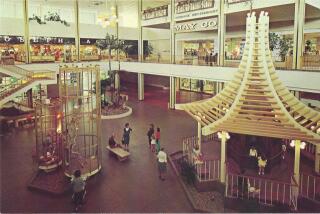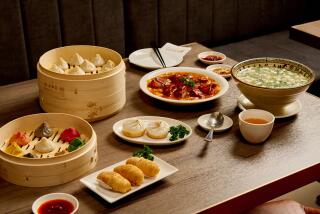Beyond the mall, food courts turn into gourmet destinations

The rejuvenated Grand Central Market, a historic open marketplace in downtown Los Angeles, is drawing droves of customers with its mix of eateries, game nights and other cultural events.
The great American food court that rose with the shopping malls of the 1970s is fast disappearing. And in its place is the modern equivalent: a curated roster of restaurants and food purveyors that are more likely to serve a grass-fed beef burger on a brioche bun than a hot dog on a stick. In fact, a food court was just named one of the best new restaurants of the year by a national magazine.
The grand food hall in many ways might be displacing the old standby shopping mall in Southern California as a community gathering place. The rejuvenated Grand Central Market, a historic open marketplace in downtown Los Angeles, is drawing droves of customers with its mix of high-end butcher and cheese shops, gourmet breakfast sandwiches, Thai food, Texas barbecue, carnitas tacos and more, along with game nights, DJs and other cultural events.
And it’s garnering a lot of attention: Bon Appétit magazine recently named it one of the year’s 10 “best new restaurants” in the country.
------------
FOR THE RECORD:
Anaheim Packing District: In an article about food courts in the Aug. 30 Saturday section, the website for the Anaheim Packing District (which includes the Anaheim Packing House) was incorrect. The correct address is www.anaheimpackingdistrict.com.
------------
The Anaheim Packing House in downtown Anaheim is similarly imagined. It opened this summer in a nearly 100-year-old, 42,000-square-foot Spanish Revival former citrus packing plant, with local coffee, small-batch ice cream, a butcher (which now seems obligatory) and a neighborhood market, among many other new shops and restaurants.
“People are tired of shopping malls and supermarkets,” said developer Shaheen Sadeghi during construction. “There’s a resurgence of food artisans and non-chain operators.”
Sadeghi saw it as a community hub inspired by markets such as Mercado del Puerto in Montevideo, Uruguay; Boqueria in Barcelona; and Granville Island Public Market in Vancouver, Canada.
Downtown’s Market in L.A. at the Medallion is expected to house chef-driven restaurants, street food stalls and a farmers market. It’s slated to open in phases within the next several months.
And the Spring Arcade Building, also in downtown L.A., is undergoing a transformation that is replacing stalls selling DVDs and electronics with restaurants and shops including Uli gelateria, Guisados tacos and a forthcoming restaurant from Austrian chef Bernhard Mairinger in what looks like a passage courvert straight from Paris.
Meanwhile, traditional shopping malls are following the same cue and adapting to the demands of customers’ new tastes. Developers don’t call them food courts anymore; like Grand Central Market or Anaheim Packing House, they too are food halls. The Beverly Center, owned by the Taubman Co., is in the middle of overhauling its food court — er, food hall — set to open in 2015 with dining options that are expected to reflect L.A.’s dining scene, with local restaurants and chefs.
When the Figat7th shopping center downtown recently underwent a $40-million overhaul, its “food hall” became its centerpiece, designed by architecture firm Gensler with indoor/outdoor seating, natural lighting and wood finishes that contributed to the aim of a warmer environment.
“It’s not all pizza and burgers and everything’s orange,” said Ed Hogan, national director of retail leasing for Brookfield Properties. Among the dining choices are local favorites such as Loteria Grill, Mendocino Farms and Sprinkles Cupcakes.
It’s meant to be a neighborhood hangout, said Hogan. “What we did not want was to do a food court.”
Follow me on Twitter: @bettyhallock
More to Read
Eat your way across L.A.
Get our weekly Tasting Notes newsletter for reviews, news and more.
You may occasionally receive promotional content from the Los Angeles Times.







